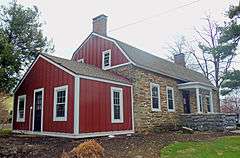Bergh–Stoutenburgh House
|
Bergh–Stoutenburgh House | |
|
North profile and west (front) elevation, 2013 | |
| Location | Hyde Park, NY |
|---|---|
| Nearest city | Poughkeepsie |
| Coordinates | 41°46′55″N 73°55′55″W / 41.78194°N 73.93194°WCoordinates: 41°46′55″N 73°55′55″W / 41.78194°N 73.93194°W |
| Built | 1770s[1] |
| Architectural style | Dutch Colonial |
| NRHP Reference # | 72000829 |
| Added to NRHP | 1972 |
The Bergh–Stoutenburgh House is located on U.S. Route 9 opposite Mansion Drive in Hyde Park, New York, United States. It was until recently home to Edo Sushi, a Japanese restaurant. The restaurant closed its Hyde Park location and moved to nearby Poughkeepsie in the fall of 2012. The Bergh–Stoutenburgh House is currently occupied by Sue Serino and Chris Gibson as their political office.
Built before the Revolutionary War, it is one of only two remaining Dutch Colonial stone houses in Hyde Park.[2] It is a five-by-two-bay one-story building with a slate-covered gambrel roof pierced by two brick chimneys at the gable ends. It is sided in uncoursed fieldstone, with clapboard on the gable ends.[1]
Two small frame wings project from the north and east (rear). An arched doorway on the south leads to the cellar. The main entrance has a flat-roofed wooden portico.[1]
John Bergh inherited the lands from his father Christian in the years before the Revolution, along with his brother-in-law Martin Dop. Both of them built houses on them sometime between 1771 and 1780, as they appear on a map of the Albany Post Road (later to become Route 9 through Hyde Park) drawn by Robert Erskine, Surveyor-General of the Continental Army, in the last years of his life, between 1778 and 1780.[1]
In 1788 Bergh sold a hundred acres (40 ha) to Jacobus Stoutenburgh II. His daughter Margaret, in turn, eventually inherited the property. It remained in use as a house throughout the 19th century and into much of the 20th. It was still a residence when it was listed on the National Register of Historic Places in 1972,[1] the first property in Hyde Park listed on the Register in its own right.[3] At some point since it was converted into Edo Sushi. The restaurant heavily remodeled the interior in keeping with Japanese dining traditions, though it still retains some of the original furnishings, such as the fireplace.[4]
See also
References
- 1 2 3 4 5 Weaver, Lynn Beebe (July 1972). "National Register of Historic Places nomination, Bergh-Stoutenburgh House". New York State Office of Parks, Recreation and Historic Preservation. Retrieved May 20, 2009.
- ↑ Marquez, Margaret Logan (1996). Hyde Park on the Hudson. Mount Pleasant, SC: Arcadia Publishing. p. 48. ISBN 978-0-7385-6240-7. Retrieved May 20, 2009.
The oldest houses in the village, of which only two are standing, are what we may call Colonial Dutch. Mr. Bergh bought the lot in 1771, which his son inherited and sold with the house to Jacobus Stoutenburgh II in 1780 — hence the designation of Bergh-Stoutenburgh House
- ↑ The Home of Franklin D. Roosevelt National Historic Site and Vanderbilt Mansion National Historic Site were listed when the Register was created in 1966, but that was purely administrative as both had been designated as National Historic Sites many years earlier.
- ↑ "Pictures of the Restaurant". Edo Sushi Japanese Restaurant. Archived from the original on February 19, 2009. Retrieved May 20, 2009.


